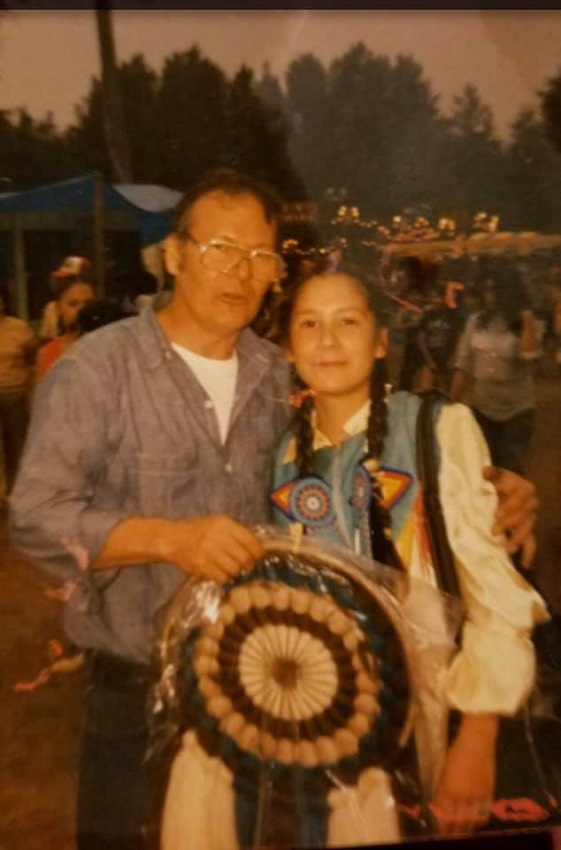Menominee tribal member Rae Elaine Tourtillott was 18 when she went missing on the tribe’s reservation during the fall of 1986. Her remains were found the following spring. The case remains unsolved and no arrests have been made in connection with her murder. The FBI and Menominee Tribal Police are still seeking information on her death.
Tourtillott’s daughter, Alysse Arce, and cousin, Andrea Lemke-Rochon, sat down to talk about her with WPR’s Danielle Kaeding. They also shared their hopes for a new Missing and Murdered Indigenous Women Task Force, which is led by Wisconsin’s Department of Justice to “help fight the abduction, homicide, violence and trafficking of Indigenous women in Wisconsin.”
According to a WPR news story, violence against Native women is often underreported and missing person cases don’t always make it into a national database. Also, research shows Indigenous women are three times more likely to be murdered than white women.
(The following interview has been edited for brevity and clarity.)
==
Andrea Lemke-Rochon: Rae Elaine was pure joy. She and I grew up together. (When) we were kids, she lived on the reservation, and I didn’t so I loved whenever we would go visit. She was laughing all the time. She was a huge joker and just a really beautiful girl and a really beautiful young woman and that beauty radiated really from the inside out.
Alysse Arce: I just knew that she was really outgoing, and she had a lot of spirit and a lot of lift. She loved to dance, pow wow dance. She was a Menominee Princess. She was very into our culture, singing and drumming class, Menominee language…
ALM: The time we would spend together, she would try to teach me Menominee. She tried to teach me to dance. She told me I was a hopeless dancer. I never quite could do it, but she was a gorgeous dancer. She did fancy dancing and that’s supposed to mimic a butterfly. And, Rae Elaine looked like a butterfly embodied when she danced. It was just really beautiful.
AA: And she was very family-oriented.
ALM: I hadn’t seen Alysse in a few years, and I had gone back up for a family gathering at my cousin Rae’s sister’s house. And Alysse and I – Alysse, you were a teenager – but, we were on a pontoon boat ride together. And, Alysse threw her head back and laughed, and I thought, “Oh my god, there she is. There’s Rae. There’s Rae Elaine right there – right in front of me.”
AA: It’s nice to hear stuff like that because a part of me feels like she’s living through me. She’s always around me all the time.

Rae Elaine (r) with her infant daughter, Alysse, and boyfriend, Bob. (Courtesy of Andrea Lemke-Rochon)
ALM: I remember getting a message saying you need to call home right away. It was in October of 1986. And, I called home and my mom was sobbing. She just couldn’t even get the words out to tell me that Rae was missing. And, I couldn’t wrap my head around it because I know she had just given birth to Alysse.
AA: I was only two months old when this happened. This was something that kind of shook our whole reservation – from what I know – because my aunties kept newspaper clippings and everything from way back then.
ALM: We learned that part of her body had been found in a beaver dam on the reservation, so it was very, very hard.
AA: I just don’t want any other family to go through what we went through. I see and I know the pain of my family because I can see it in their eyes and how they are.
- Alysse Arce and her son, Coltyn. (Courtesy of Alysse Arce)
- Andrea Lemke-Rochon (Courtesy of Andrea Lemke-Rochon)
- Alysse Arce and her son, Coltyn. (Courtesy of Alysse Arce)
ALM: I think that this missing and murdered Indigenous women work is the first time that I feel like there’s something tangible that I can do to try to make a difference.
We really do want to raise awareness that this is a problem impacting Native women and Native girls, and we need it to stop and we want it to stop.
AA: It’s something that needs to be fixed within the system. And, that’s why I’m saying like I don’t want any other family dealing with what we are dealing with. I don’t want people going off with cold cases for 34 years. I don’t want them to have this pain that we carry around with us every day. That’s what I want out of this. Because, I mean – and I feel like that would be her only justice of this is to help other families because nobody should ever have to feel what we felt.
- Rae Elaine Tourtillott with her dad, Bernard Toutillott. (Courtesy of Andrea Lemke-Rochon)
- Lorraine Shooter at a march wearing a shirt and holding a sign with Rae Elaine Tourtillot on it. (Courtesy of Andrea Lemke-Rochon)

















